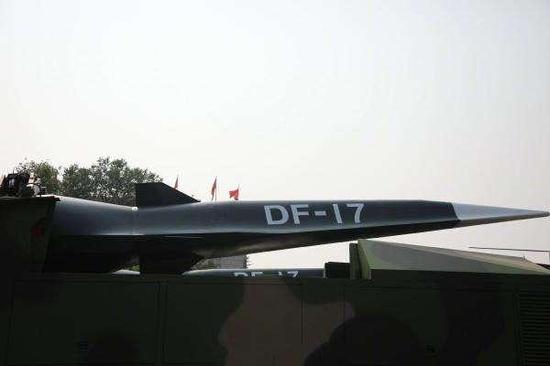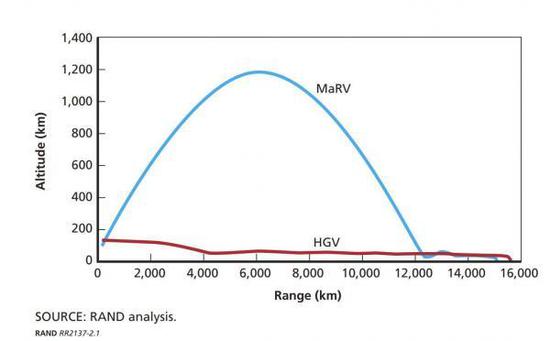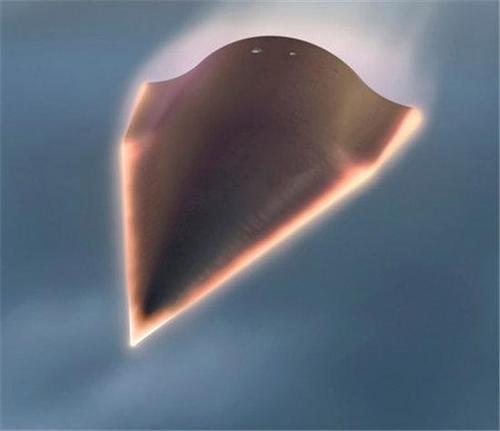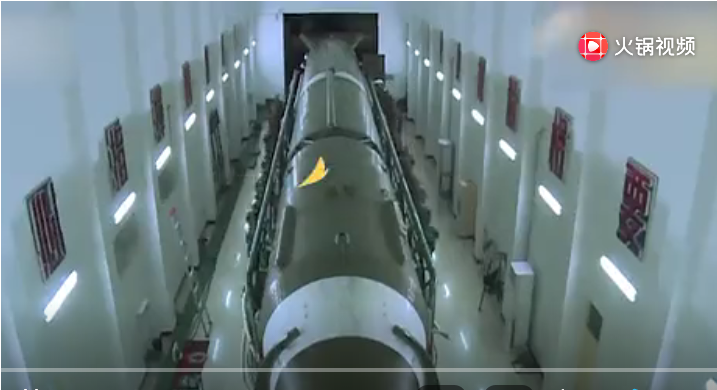- Joined
- Jul 9, 2011
- Messages
- 2,759
- Points
- 48
Want to copycat my war toys? Hahahaha! Pay attention to ultra flat and low trajectory / orbit / hard time trying to use radar to detect / track the HGV warheads. Do your have what it takes?
https://mil.news.sina.com.cn/jssd/2019-10-04/doc-iicezzrr0058365.shtml
我军东风17导弹采用助推滑翔弹道 最快可达10倍音速
我军东风17导弹采用助推滑翔弹道 最快可达10倍音速
83
本期川陀太空仅从助推-滑翔弹道上解读这个载具的基本性能。从弹道抛物面上看,助推-滑翔弹道需要有一个助推段,因此我们看到东风17有两个部分构成,第一个助推段,第二个是滑翔飞行器,前端长得像飞机的载具就是滑翔分析器。
高超音速技术给人一种非常陌生的感觉,从定义上看,其速度要达到每秒5倍音速以上,该技术从1970年代开始发展,主要制约因素就是材料、发动机等。但理论上发展却很早,在1940年代就有人提出了利用再入大气层的方式延长火箭的射程,1948年,年轻的钱学森提出了助推-滑翔弹道,也是目前高超音速领域最流行的理论基础,可以将载具的射程提升至少一倍。本次大阅兵上出现的东风17载具就采用了高超音速飞行技术,川陀太空指出,前端类似小飞机模样的载具能够在大气层中做无动力滑翔飞行,这也是我国在高超音速领域有长足进步的缩影。

图注:高超音速飞行技术是个全新的领域,其飞行器为有翼结构。
公开展示气动外形也说明我国在高超音速载具方面有着相当的自信,目前能够开发相关技术的只有美俄,目前美国在高超音速载具方面停滞不前,俄罗斯已经有较为成熟的高超音速飞行器。
助推-滑翔弹道技术已被我国掌握
从科学技术角度分析东风17的载具,入手无非是高超音速飞行器相关技术要点,除了材料、发动机、气动之外,本期川陀太空仅从助推-滑翔弹道上解读这个载具的基本性能。从弹道抛物面上看,助推-滑翔弹道需要有一个助推段,因此我们看到东风17有两个部分构成,第一个助推段,第二个是滑翔飞行器,前端长得像飞机的载具就是滑翔分析器。

图注:DF17载具
助推段比较简单,就是第一级火箭,工作高度至数十公里,然后依靠惯性继续上升并冲出大气层,这段时间载具做无动力自由飞行,也是进入轨道了。接着再入大气层依靠气动升力进行滑翔,这也是我们看到载具有机翼结构的原因,需要在大气层内进行滑翔飞行,速度至上在10倍音速以上。此时的弹道有两种模式,第一种是高度逐渐降低的滑翔弹道,第二种是跳跃弹道,高度有起伏。大气层就像是一个稠密的介质,这个原理和我们小时候打水上漂一样,最好选择扁平、且有弧度的碎瓦砾,小瓦片是最理想的,能够在水上漂很远。
东风17的载具有机翼结构,就能够在大气层进行“水上漂”,能够飞行很远的距离,至少上千公里。因此出现在阅兵上的东风17及其载具则是风靡全球的高超音速技术,已悄然到我们身边,展示在我们面前,这是我国航天科技长足进步、逐渐成熟、自信的表现。

图注:HGV为高超音速飞行器弹道剖面,全程高度都很低。
黑障问题是关键
高超音速飞行器在临近空间进行飞行,高度至少在20公里以上,虽然这种飞行方式很独特、优雅、逼格很高,但大气层也是非常稠密的,意味着摩擦非常剧烈,飞行器周围温度会急剧上升。这时候空气分子还会发生电离,形成厚度不均的等离子体鞘将飞行器给包裹住。于是问题来了,无线电波是无法穿透等离子体鞘,这就是我们所说的黑障。对于神舟飞船、航天飞机等再入航天器,黑障过程不超过10分钟,短一些4分钟就结束了,但是对于高超音速飞行器,黑障会持续很久。

图注:高超音速飞行器需要克服黑障、耐高温材料等问题
因此我们看到东风17的载具设计得修长,头部前缘为尖形,这样能够让天线周围的等离子体鞘变薄,那么通信就可以建立。虽然理论上是这样,但仍然需要科研人员进行长时间的测试。
综上,我们在阅兵中看到了小飞机模样的载具,其实就是我国最新、最先进的高超音速飞行器,它的出现对于建立我国防安全有非常重大的意义。(作者署名:川陀太空)
Our military Dongfeng 17 missile uses boosting gliding trajectory up to 10 times the speed of sound
Our military Dongfeng 17 missile uses boosting gliding trajectory up to 10 times the speed of sound
83
In this issue, Kawaku Space only interprets the basic performance of this vehicle from the boost-gliding trajectory. From the ballistic paraboloid, the boost-gliding trajectory needs to have a boosting segment, so we see that the Dongfeng 17 has two parts, the first booster segment, the second one is a gliding aircraft, and the front end looks like an airplane. The vehicle is the gliding analyzer.
Hypersonic technology gives people a very strange feeling. By definition, its speed should be more than 5 times the speed of sound per second. The technology has been developed since the 1970s. The main constraints are materials and engines. However, in theory, the development was very early. In the 1940s, some people proposed to use the way of re-entry into the atmosphere to extend the range of the rocket. In 1948, the young Qian Xuesen proposed the boost-gliding trajectory, which is also the most popular theoretical basis in the current hypersonic field. Can increase the range of the vehicle by at least one time. The Dongfeng 17 vehicle that appeared on the military parade used supersonic flight technology. Chuanto Space pointed out that the vehicle with a front-end resemblance of a small aircraft can make unpowered gliding in the atmosphere. This is also the case in China's hypersonic range. The epitome of great progress.
Legend: Hypersonic flight technology is a new field, and its aircraft is winged.
The public display of aerodynamic shape also shows that China has considerable confidence in hypersonic vehicles. At present, only the United States and Russia can develop related technologies. At present, the United States is stagnating in hypersonic vehicles. Russia already has more mature hypersonic vehicles.
Boost-gliding trajectory technology has been mastered in China
From the perspective of science and technology, the analysis of the Dongfeng 17 vehicle is nothing more than the technical point of the hypersonic vehicle. In addition to materials, engines and aerodynamics, the current Chuandao space only interprets the basic performance of the vehicle from the boost-gliding trajectory. . From the ballistic paraboloid, the boost-gliding trajectory needs to have a boosting segment, so we see that the Dongfeng 17 has two parts, the first booster segment, the second one is a gliding aircraft, and the front end looks like an airplane. The vehicle is the gliding analyzer.
Legend: DF17 Vehicle
The booster segment is relatively simple. It is the first-stage rocket, working at a height of tens of kilometers, and then continues to rise and rush out of the atmosphere by inertia. During this time, the vehicle is flying without power and is also in orbit. Then re-entry into the atmosphere depends on aerodynamic lift for gliding. This is why we see the structure of the wing, and we need to fly in the atmosphere, the speed is above 10 times the speed of sound. There are two modes of ballistics at this time. The first is a glide trajectory with a gradually decreasing height, and the second is a jumping trajectory with a height undulation. The atmosphere is like a dense medium. This principle is the same as when we were a child. It is best to choose flat and curved rubble. Small tiles are ideal and can drift far away on the water.
The Dongfeng 17 has a wing structure that allows it to “water float” in the atmosphere and can fly very far, at least a thousand kilometers. Therefore, the Dongfeng 17 and its vehicles that appeared on the military parade were the supersonic technology that swept the world. They have quietly come to us and displayed in front of us. This is a manifestation of China's aerospace science and technology progress, maturity and self-confidence.
Legend: HGV is a high-sonic aircraft ballistic profile with a low overall height.
Black obstacle problem is the key
The hypersonic aircraft is flying in the adjacent space, at least 20 kilometers in height. Although this flight mode is unique, elegant and high, the atmosphere is very dense, which means the friction is very intense and the temperature around the aircraft will rise sharply. . At this time, the air molecules will also ionize, forming a plasma sheath with uneven thickness to wrap the aircraft. So the problem came, the radio waves could not penetrate the plasma sheath, which is what we call the blackout. For re-entry spacecraft such as Shenzhou spacecraft and space shuttle, the blackout process will not exceed 10 minutes, and the short 4 minutes will end, but for hypersonic vehicles, the blackout will last for a long time.
Legend: Hypersonic vehicles need to overcome problems such as blackouts and high temperature materials.
Therefore, we can see that the Dongfeng 17 vehicle is designed to be slender and the leading edge of the head is pointed, so that the plasma sheath around the antenna can be thinned, and communication can be established. Although this is theoretically the case, researchers are still required to conduct long-term testing.
In summary, we saw a small aircraft-like vehicle in the military parade. It is actually the newest and most advanced hypersonic vehicle in China. Its appearance is of great significance for establishing my national defense security. (Author's signature: Kawaka Space)
https://mil.news.sina.com.cn/jssd/2019-10-04/doc-iicezzrr0058365.shtml
我军东风17导弹采用助推滑翔弹道 最快可达10倍音速
我军东风17导弹采用助推滑翔弹道 最快可达10倍音速
83
本期川陀太空仅从助推-滑翔弹道上解读这个载具的基本性能。从弹道抛物面上看,助推-滑翔弹道需要有一个助推段,因此我们看到东风17有两个部分构成,第一个助推段,第二个是滑翔飞行器,前端长得像飞机的载具就是滑翔分析器。
高超音速技术给人一种非常陌生的感觉,从定义上看,其速度要达到每秒5倍音速以上,该技术从1970年代开始发展,主要制约因素就是材料、发动机等。但理论上发展却很早,在1940年代就有人提出了利用再入大气层的方式延长火箭的射程,1948年,年轻的钱学森提出了助推-滑翔弹道,也是目前高超音速领域最流行的理论基础,可以将载具的射程提升至少一倍。本次大阅兵上出现的东风17载具就采用了高超音速飞行技术,川陀太空指出,前端类似小飞机模样的载具能够在大气层中做无动力滑翔飞行,这也是我国在高超音速领域有长足进步的缩影。

图注:高超音速飞行技术是个全新的领域,其飞行器为有翼结构。
公开展示气动外形也说明我国在高超音速载具方面有着相当的自信,目前能够开发相关技术的只有美俄,目前美国在高超音速载具方面停滞不前,俄罗斯已经有较为成熟的高超音速飞行器。
助推-滑翔弹道技术已被我国掌握
从科学技术角度分析东风17的载具,入手无非是高超音速飞行器相关技术要点,除了材料、发动机、气动之外,本期川陀太空仅从助推-滑翔弹道上解读这个载具的基本性能。从弹道抛物面上看,助推-滑翔弹道需要有一个助推段,因此我们看到东风17有两个部分构成,第一个助推段,第二个是滑翔飞行器,前端长得像飞机的载具就是滑翔分析器。

图注:DF17载具
助推段比较简单,就是第一级火箭,工作高度至数十公里,然后依靠惯性继续上升并冲出大气层,这段时间载具做无动力自由飞行,也是进入轨道了。接着再入大气层依靠气动升力进行滑翔,这也是我们看到载具有机翼结构的原因,需要在大气层内进行滑翔飞行,速度至上在10倍音速以上。此时的弹道有两种模式,第一种是高度逐渐降低的滑翔弹道,第二种是跳跃弹道,高度有起伏。大气层就像是一个稠密的介质,这个原理和我们小时候打水上漂一样,最好选择扁平、且有弧度的碎瓦砾,小瓦片是最理想的,能够在水上漂很远。
东风17的载具有机翼结构,就能够在大气层进行“水上漂”,能够飞行很远的距离,至少上千公里。因此出现在阅兵上的东风17及其载具则是风靡全球的高超音速技术,已悄然到我们身边,展示在我们面前,这是我国航天科技长足进步、逐渐成熟、自信的表现。

图注:HGV为高超音速飞行器弹道剖面,全程高度都很低。
黑障问题是关键
高超音速飞行器在临近空间进行飞行,高度至少在20公里以上,虽然这种飞行方式很独特、优雅、逼格很高,但大气层也是非常稠密的,意味着摩擦非常剧烈,飞行器周围温度会急剧上升。这时候空气分子还会发生电离,形成厚度不均的等离子体鞘将飞行器给包裹住。于是问题来了,无线电波是无法穿透等离子体鞘,这就是我们所说的黑障。对于神舟飞船、航天飞机等再入航天器,黑障过程不超过10分钟,短一些4分钟就结束了,但是对于高超音速飞行器,黑障会持续很久。

图注:高超音速飞行器需要克服黑障、耐高温材料等问题
因此我们看到东风17的载具设计得修长,头部前缘为尖形,这样能够让天线周围的等离子体鞘变薄,那么通信就可以建立。虽然理论上是这样,但仍然需要科研人员进行长时间的测试。
综上,我们在阅兵中看到了小飞机模样的载具,其实就是我国最新、最先进的高超音速飞行器,它的出现对于建立我国防安全有非常重大的意义。(作者署名:川陀太空)
Our military Dongfeng 17 missile uses boosting gliding trajectory up to 10 times the speed of sound
Our military Dongfeng 17 missile uses boosting gliding trajectory up to 10 times the speed of sound
83
In this issue, Kawaku Space only interprets the basic performance of this vehicle from the boost-gliding trajectory. From the ballistic paraboloid, the boost-gliding trajectory needs to have a boosting segment, so we see that the Dongfeng 17 has two parts, the first booster segment, the second one is a gliding aircraft, and the front end looks like an airplane. The vehicle is the gliding analyzer.
Hypersonic technology gives people a very strange feeling. By definition, its speed should be more than 5 times the speed of sound per second. The technology has been developed since the 1970s. The main constraints are materials and engines. However, in theory, the development was very early. In the 1940s, some people proposed to use the way of re-entry into the atmosphere to extend the range of the rocket. In 1948, the young Qian Xuesen proposed the boost-gliding trajectory, which is also the most popular theoretical basis in the current hypersonic field. Can increase the range of the vehicle by at least one time. The Dongfeng 17 vehicle that appeared on the military parade used supersonic flight technology. Chuanto Space pointed out that the vehicle with a front-end resemblance of a small aircraft can make unpowered gliding in the atmosphere. This is also the case in China's hypersonic range. The epitome of great progress.
Legend: Hypersonic flight technology is a new field, and its aircraft is winged.
The public display of aerodynamic shape also shows that China has considerable confidence in hypersonic vehicles. At present, only the United States and Russia can develop related technologies. At present, the United States is stagnating in hypersonic vehicles. Russia already has more mature hypersonic vehicles.
Boost-gliding trajectory technology has been mastered in China
From the perspective of science and technology, the analysis of the Dongfeng 17 vehicle is nothing more than the technical point of the hypersonic vehicle. In addition to materials, engines and aerodynamics, the current Chuandao space only interprets the basic performance of the vehicle from the boost-gliding trajectory. . From the ballistic paraboloid, the boost-gliding trajectory needs to have a boosting segment, so we see that the Dongfeng 17 has two parts, the first booster segment, the second one is a gliding aircraft, and the front end looks like an airplane. The vehicle is the gliding analyzer.
Legend: DF17 Vehicle
The booster segment is relatively simple. It is the first-stage rocket, working at a height of tens of kilometers, and then continues to rise and rush out of the atmosphere by inertia. During this time, the vehicle is flying without power and is also in orbit. Then re-entry into the atmosphere depends on aerodynamic lift for gliding. This is why we see the structure of the wing, and we need to fly in the atmosphere, the speed is above 10 times the speed of sound. There are two modes of ballistics at this time. The first is a glide trajectory with a gradually decreasing height, and the second is a jumping trajectory with a height undulation. The atmosphere is like a dense medium. This principle is the same as when we were a child. It is best to choose flat and curved rubble. Small tiles are ideal and can drift far away on the water.
The Dongfeng 17 has a wing structure that allows it to “water float” in the atmosphere and can fly very far, at least a thousand kilometers. Therefore, the Dongfeng 17 and its vehicles that appeared on the military parade were the supersonic technology that swept the world. They have quietly come to us and displayed in front of us. This is a manifestation of China's aerospace science and technology progress, maturity and self-confidence.
Legend: HGV is a high-sonic aircraft ballistic profile with a low overall height.
Black obstacle problem is the key
The hypersonic aircraft is flying in the adjacent space, at least 20 kilometers in height. Although this flight mode is unique, elegant and high, the atmosphere is very dense, which means the friction is very intense and the temperature around the aircraft will rise sharply. . At this time, the air molecules will also ionize, forming a plasma sheath with uneven thickness to wrap the aircraft. So the problem came, the radio waves could not penetrate the plasma sheath, which is what we call the blackout. For re-entry spacecraft such as Shenzhou spacecraft and space shuttle, the blackout process will not exceed 10 minutes, and the short 4 minutes will end, but for hypersonic vehicles, the blackout will last for a long time.
Legend: Hypersonic vehicles need to overcome problems such as blackouts and high temperature materials.
Therefore, we can see that the Dongfeng 17 vehicle is designed to be slender and the leading edge of the head is pointed, so that the plasma sheath around the antenna can be thinned, and communication can be established. Although this is theoretically the case, researchers are still required to conduct long-term testing.
In summary, we saw a small aircraft-like vehicle in the military parade. It is actually the newest and most advanced hypersonic vehicle in China. Its appearance is of great significance for establishing my national defense security. (Author's signature: Kawaka Space)














